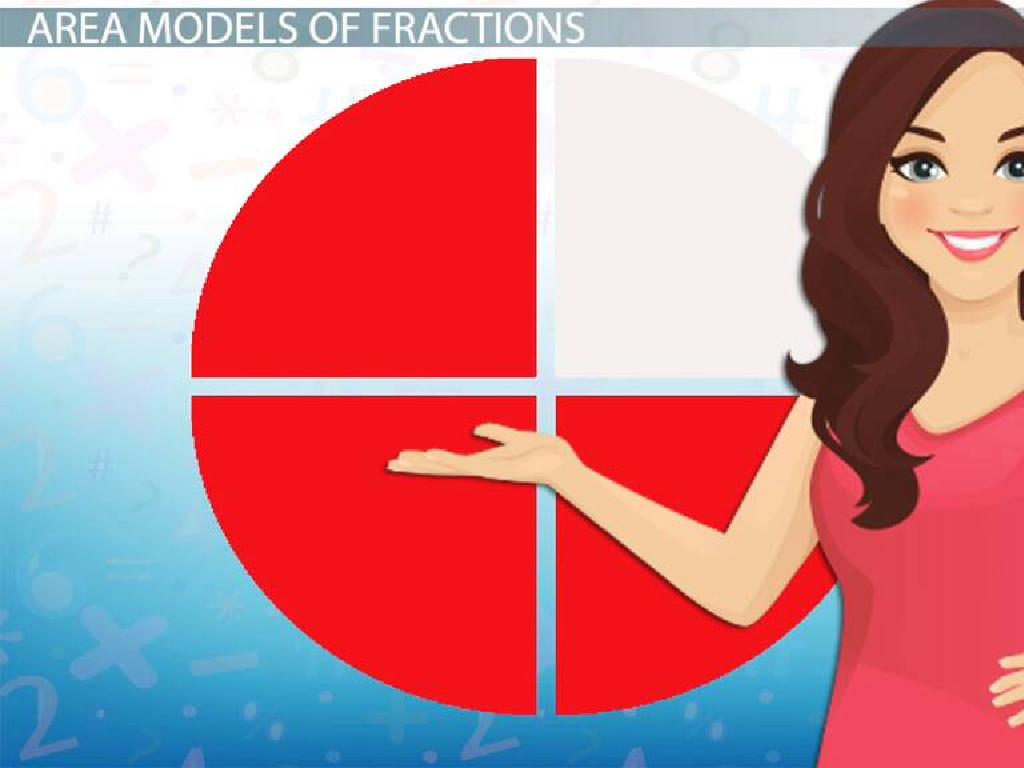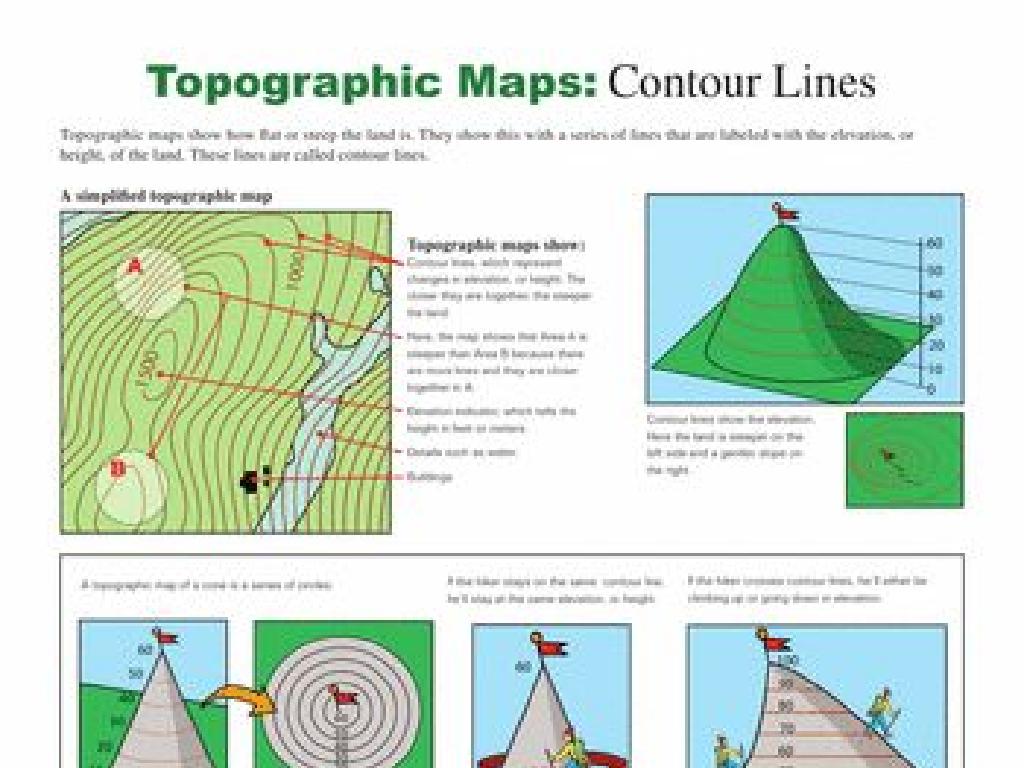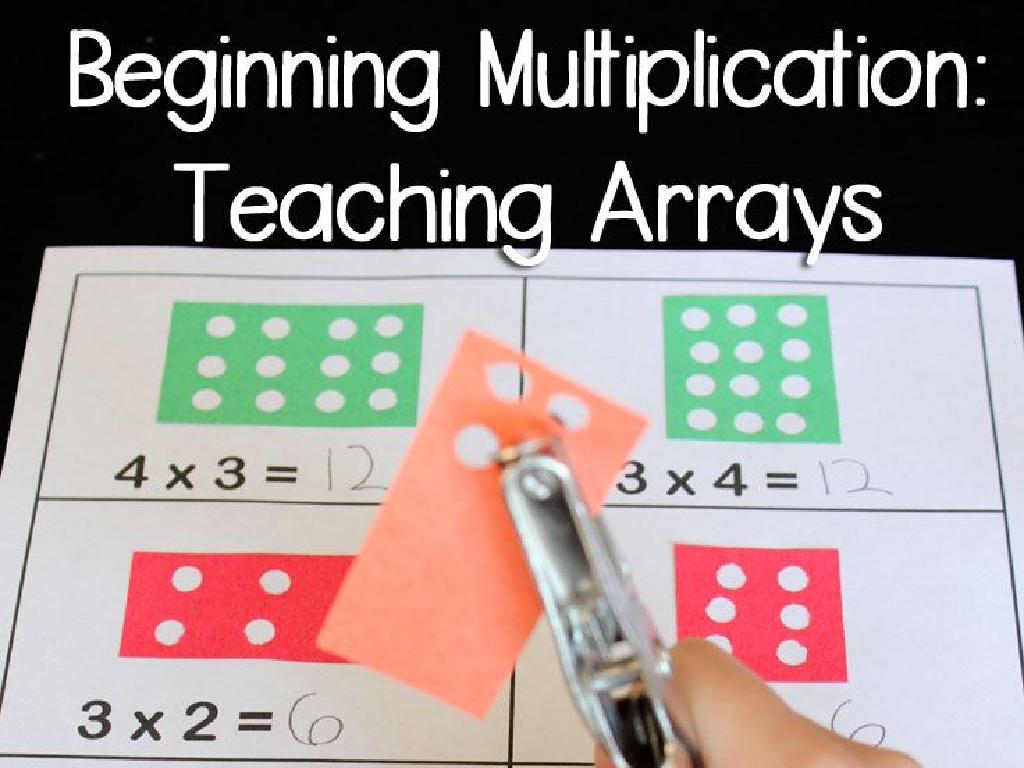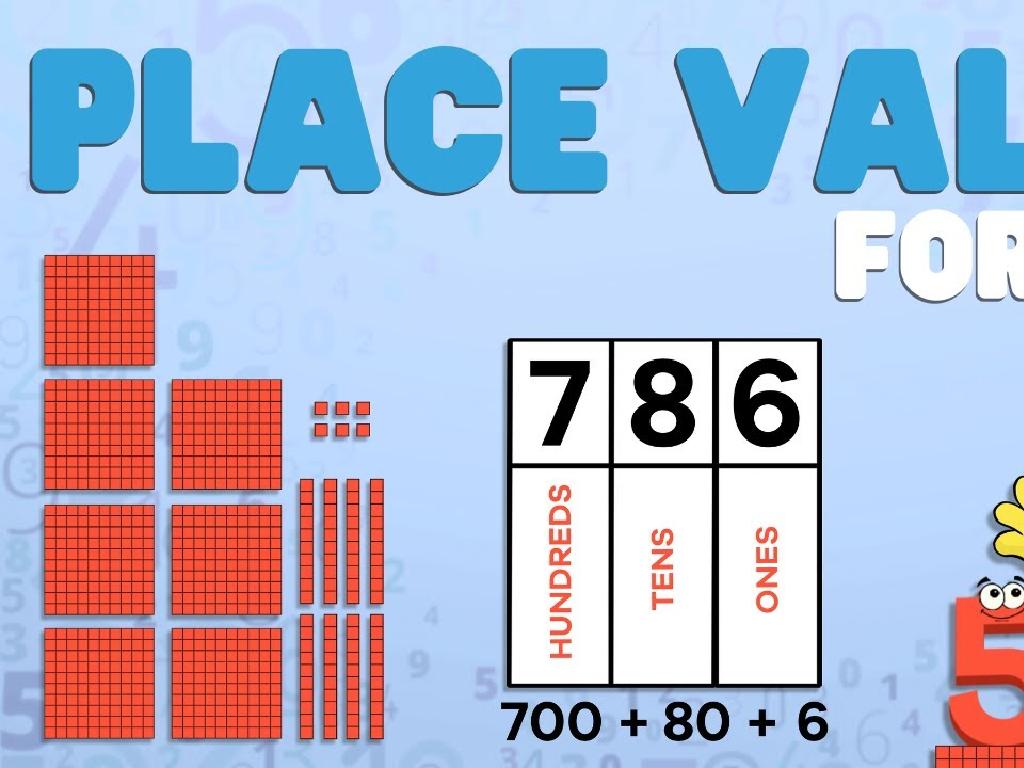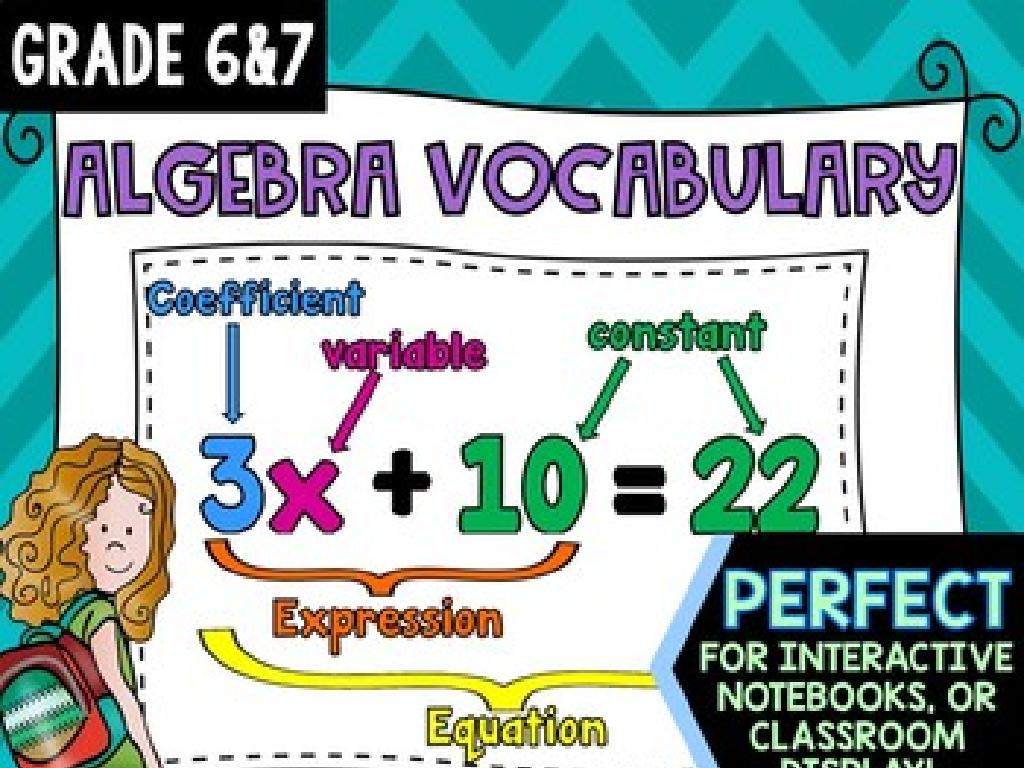Value Of A Digit - Up To Thousands
Subject: Math
Grade: Second grade
Topic: Place Value
Please LOG IN to download the presentation. Access is available to registered users only.
View More Content
Welcome to Place Value!
– Greet and introduce Place Value
– Each digit has a unique value
– In 1234, ‘1’ is in the thousands place, so it’s worth 1000
– Place Value’s role in Math
– It helps us read and write big numbers correctly
– Practice with examples
– Let’s try with numbers like 4321 and 9876
|
This slide is designed to welcome second-grade students to the concept of place value and its significance in mathematics. Begin with a friendly greeting and an introduction to what place value means. Explain that in any number, each digit has a value based on its position, or ‘place,’ within the number. Emphasize why understanding place value is crucial for working with larger numbers, as it allows us to accurately determine the value of digits in different positions. To reinforce the lesson, provide hands-on practice with examples, and encourage students to identify the value of digits in various places up to the thousands. This will set a strong foundation for future math skills.
Understanding Place Value
– What is Place Value?
– It’s the value of where a digit is in a number.
– Positions in numbers
– Ones, Tens, Hundreds, Thousands places.
– Value increases by 10x
– Each place is 10 times the value to its right.
– Practice with examples
– Let’s try 2431: 1 is in the Ones, 3 in the Tens, 4 in the Hundreds, 2 in the Thousands.
|
This slide introduces the concept of place value, which is fundamental in understanding numbers and how to work with them. Explain that the value of a digit depends on its position in a number. Illustrate with examples on the board, showing that as we move from right to left, each position represents a value 10 times greater than the position to its right. Use real-life examples like money or counting objects to make it relatable. Encourage students to practice by picking numbers and identifying the value of each digit based on its position.
Understanding Place Values Up to Thousands
– Identify digits in a number
– Determine each digit’s value
– Each position in a number has a different value
– Examples using various numbers
– 1 in 1000, 100, 10, 1 shows different values
– Practice with class activities
– Interactive games and worksheets
|
This slide introduces the concept of place value, which is fundamental to understanding the value of digits in larger numbers. Start by showing a number and identifying each digit. Then, explain how the position of each digit in a number determines its value, such as the difference between 1 in 1000 and 1 in 10. Use clear examples with numbers in different place values to illustrate the concept. Engage the students with interactive activities where they can practice identifying place values in a variety of numbers. This will help solidify their understanding through hands-on learning. Provide worksheets and consider using manipulatives like blocks or beads to represent different place values physically.
Building Numbers with Base-Ten Blocks
– Use base-ten blocks for numbers
– Base-ten blocks represent ones, tens, hundreds
– Count ones to make a ten
– 10 ones blocks stack to form a ten block
– Count tens for a hundred
– 10 tens blocks line up to make a hundred block
– Count hundreds to a thousand
– 10 hundreds blocks create a thousand block
|
This slide introduces students to the concept of place value using base-ten blocks, a visual and tactile method to understand the value of digits up to thousands. Start by explaining what each block represents (one, ten, hundred) and then show how they combine to form larger numbers. For example, it takes ten ‘ones’ to make a ‘ten’, ten ‘tens’ to make a ‘hundred’, and ten ‘hundreds’ to make a ‘thousand’. Encourage students to use actual base-ten blocks to build numbers and visually grasp the concept of place value. This hands-on activity will help solidify their understanding of how numbers are constructed in our base-ten system.
Place Value in Everyday Life
– Importance of place value
– Counting money with place value
– Each coin’s value has a place: pennies (1s), dimes (10s), dollars (100s)
– Organizing objects systematically
– Group items in 10s or 100s to count easily, like pencils or beads
– Place value in daily activities
|
Understanding place value is crucial for second graders as it is used in everyday activities such as counting money and organizing objects. When counting money, students should recognize that different coins and bills represent ones, tens, and hundreds. This helps them add up amounts efficiently. Organizing objects by tens and hundreds simplifies counting and is a practical application of place value. For example, rather than counting 100 individual pencils, grouping them into tens makes it quicker to reach the total. This slide aims to show the practicality of place value in real-life situations, making the concept more relatable and easier to grasp for the students.
Fun with Place Value
– Interactive place value game
– Arrange numbers to understand their value
– Match digits to place values
– Which digit is in the tens place? Hundreds?
– Create the largest number
– Use given digits to form the biggest number
– Create the smallest number
– Use given digits to form the smallest number
|
This slide introduces an engaging class activity focused on understanding the place value of digits up to the thousands place. The interactive game will help students visualize and arrange numbers according to their place value, reinforcing the concept that the position of a digit determines its value. For the matching activity, provide cards with digits and have students place them in the correct column of a place value chart. Challenge students to use a set of random digits to create the largest and smallest numbers possible, which will help them grasp the significance of digit placement. Encourage collaboration and discussion among students to foster a deeper understanding of place value.
Class Activity: Exploring Place Value
– Receive your place value chart
– Use number cards on the chart
– Place cards in the ones, tens, hundreds, thousands
– Create and read numbers aloud
– Practice saying numbers with classmates
|
In this interactive class activity, each student will be given a place value chart and a set of number cards. The objective is to help students understand the value of digits in different places, up to the thousands place. Students will use the number cards to fill in the chart, thereby creating various numbers. They will then practice reading these numbers aloud, which will reinforce their understanding of place value. For the teacher: Prepare place value charts and number cards beforehand. Ensure each student understands the chart’s columns: ones, tens, hundreds, and thousands. Circulate the room to assist and check for understanding. Possible variations of the activity could include having students exchange charts to read each other’s numbers, or challenging them to create the largest or smallest number possible with their cards.
Place Value Review & Importance
– Recap place value concepts
– Importance of place value
– Knowing place value helps in understanding the value of numbers and in performing calculations.
– Engage in Q&A session
– Ask any questions about place value and let’s answer them together!
– Summarize key takeaways
– Remember how each position in a number changes its value.
|
This slide aims to consolidate the students’ understanding of place value up to the thousands place. Begin by reviewing the concepts taught, such as the value of digits depending on their place in a number. Emphasize the importance of place value in everyday math, such as adding, subtracting, and comparing numbers. Open the floor for a Q&A session to address any uncertainties the students may have, ensuring they feel confident in their knowledge. Conclude by summarizing the key points, reinforcing that place value is the foundation of our number system and is crucial for their future math skills development.
Place Value Craft: Making an Abacus
– Create a paper roll abacus
– Use paper rolls and beads to make a tool for counting.
– Learn place values with beads
– Each column represents a place value: ones, tens, hundreds, thousands.
– Share and explain your abacus
– Show your classmates how your abacus works.
– Understand digit values
– Explain how each bead’s position shows its value.
|
This hands-on activity is designed to help second graders understand the concept of place value up to the thousands place. By creating their own abacus using paper rolls and beads, students will be able to visualize and manipulate the beads to represent different values. Each student will have the opportunity to share their creation with the class and explain how the placement of beads represents different digits in numbers. This activity not only reinforces the concept of place value but also encourages peer learning and presentation skills. As a teacher, prepare to assist students in crafting their abacus and guide them in understanding how to use it to represent numbers. Have a few examples ready to demonstrate, and consider preparing a worksheet with numbers for students to represent on their abacus.

